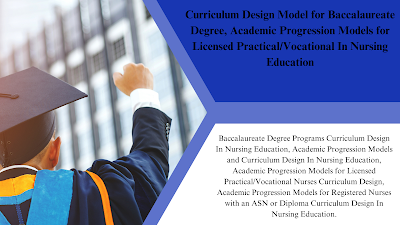The Curriculum Design Model for Baccalaureate Degree Academic Progression Models for Licensed Practical or Vocational In Nursing Education. Curriculum organization typically follows one of three models: block-based, concept-based, or competency-based.
The Curriculum Design Model for Baccalaureate Degree Academic Progression Models for Licensed Practical or Vocational In Nursing Education
Baccalaureate nursing programs, including BSN, BS, and BA degrees, are typically offered by four-year colleges and universities. However, recent developments have seen 19 states allowing community colleges to confer bachelor’s degrees (Robert Wood Johnson Foundation, 2013). Graduates of these programs are equipped to provide comprehensive care across various settings, including hospitals, homes, and community health environments.
A common approach to designing undergraduate nursing programs for students with prior nursing experience (LPN/LVN) is to use academic progression models that incorporate and build upon existing knowledge and skills. These models often include agreements, fluid progression paths, and course credit opportunities.
Core Components of the Curriculum
A well-rounded baccalaureate curriculum integrates advanced nursing concepts with a robust foundation in liberal arts and sciences. Key components include:
- Nursing Theory and Research: Foundation in theoretical frameworks and research methodologies.
- Management and Health Policy: Skills in healthcare management, policy-making, and leadership.
- Community Health and Patient Education: Emphasis on preventive care, health promotion, and patient education.
Students may enter the nursing program after completing prerequisite courses in sciences, arts, and humanities, or they may complete these courses concurrently with their nursing studies. Flexibility in curriculum design is crucial to adapting to evolving practice expectations and meeting the growing demand for baccalaureate-prepared nurses (Institute of Medicine, 2010).
Creating Effective Curriculum
Faculty should focus on designing curricula that respond to the dynamic needs of healthcare and incorporate evidence-based practices. Essential competencies include clinical reasoning, inter-professional collaboration, leadership, and health policy advocacy. Collaboration with academic and practice partners is vital to developing a curriculum that prepares students for the complexities of modern healthcare (Niederhauser et al., 2010).
Academic Progression Models and Curriculum Design in Nursing Education
Importance of Academic Progression Models
Academic progression models are vital for nursing education, providing pathways for students to advance through different educational levels efficiently. These models address the need for advanced education and skills in nursing and streamline the transition between degree programs.
Characteristics of Effective Models
Successful academic progression models share several key features:
- Accelerated Degree Progression: Strategies to shorten the time required to move from one academic level to another.
- Recognition of Prior Learning: Incorporation of previously earned credits and relevant experience.
- Transferability of Credits: Ensuring that educational credits can be easily transferred between programs.
These models help bridge gaps and reduce inefficiencies in advancing nursing education.
Academic Progression Models for Licensed Practical/Vocational Nurses (LPN/LVN)
LPN/LVN to ASN and BSN Pathways
Licensed Practical Nurses (LPNs) and Licensed Vocational Nurses (LVNs) often pursue further education for various reasons, including faster program completion and affordability. Common academic progression pathways include:
- LPN to ASN (Associate of Science in Nursing)
- LPN to BSN (Bachelor of Science in Nursing)
These pathways provide a crucial entry point into nursing, often attracting a diverse range of students, including those from minority backgrounds and non-traditional students (Porter Wenzlaff & Froman, 2008). Effective programs offer support to enhance academic skills and address financial barriers.
Educational Models
Programs like the National League for Nursing (NLN) Education Competencies Model facilitate seamless transitions across nursing education levels, ensuring that LPNs and LVNs can advance their careers efficiently.
Academic Progression Models for Registered Nurses with ASN or Diploma
RN to BSN and ASN to MSN Pathways
Registered Nurses (RNs) with an Associate of Science in Nursing (ASN) or a diploma can pursue advanced degrees through various academic progression models:
- RN to BSN (Bachelor of Science in Nursing)
- ASN to MSN (Master of Science in Nursing)
These programs often integrate additional coursework in community health, nursing leadership, and evidence-based practice. They may also include capstone projects and clinical nursing courses to consolidate learning outcomes.
Flexible Learning Options
To accommodate diverse learners, many programs offer flexible formats, including:
- Day, Evening, or Weekend Classes: Allowing students to balance work and study.
- Hybrid Models: Combining online and in-person classes for convenience and support.
- Fully Online Programs: Providing flexibility and self-paced learning opportunities.
These innovative formats help RN students advance their education while maintaining their professional responsibilities.
Advancing the Nursing Workforce
Programs that facilitate the RN to MSN transition often grant the BSN degree along the way, providing streamlined pathways to higher educational and professional levels. Such models are crucial for addressing the growing need for advanced practice nurses and improving the overall quality of patient care.
Read More:
https://nurseseducator.com/didactic-and-dialectic-teaching-rationale-for-team-based-learning/
https://nurseseducator.com/high-fidelity-simulation-use-in-nursing-education/
First NCLEX Exam Center In Pakistan From Lahore (Mall of Lahore) to the Global Nursing
Categories of Journals: W, X, Y and Z Category Journal In Nursing Education
AI in Healthcare Content Creation: A Double-Edged Sword and Scary
Social Links:
https://www.facebook.com/nurseseducator/
https://www.instagram.com/nurseseducator/
https://www.pinterest.com/NursesEducator/
https://www.linkedin.com/in/nurseseducator/
https://www.researchgate.net/profile/Afza-Lal-Din
https://scholar.google.com/citations?hl=en&user=F0XY9vQAAAAJ
